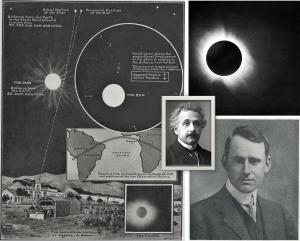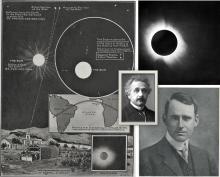Weighty Eclipse [1]
When the year 1919 began, Albert Einstein was a little-known German physicist. By year’s end, though, he was an international celebrity — probably the most famous scientist in the world. The difference? A total solar eclipse that took place 100 years ago today.
A few years earlier, Einstein had published his theory of gravity, known as general relativity. Among other things, it said that mass causes space-time to curve. That could be confirmed during a solar eclipse. As light from background stars passed close to the Sun, it would be deflected a tiny bit. That would make the stars appear to be out of their normal positions.
Frank Watson Dyson, Britain’s astronomer royal, proposed testing that idea during the solar eclipse of May 29th, 1919. So two expeditions headed out to watch it. Arthur Eddington, another top British astronomer and an admirer of Einstein’s work, led a group to an island off the coast of Africa. The other group went to Brazil.
Weather conditions weren’t the best. Clouds and rain blocked part of Eddington’s view. And the heat in Brazil warped the mirror of the Brazilian group’s main telescope. Even so, both groups got some observations. They then spent months analyzing their findings. They reported that their observations were a good match to Einstein’s theory. Einstein appeared on the front pages of newspapers around the world — making him an instant celebrity.
More about general relativity tomorrow.
Script by Damond Benningfield


